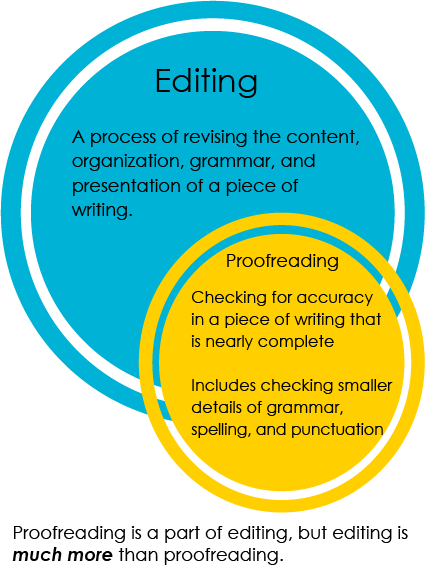26 Self-Edit Your Work

After you have finished creating a first draft of your paper, you will want to begin the process of editing and revising. Editing is an important part of the writing process that allows you to present your ideas in the clearest and most effective way possible. It involves making improvements to all of a paper – the thesis, how the arguments are organized, paragraph structure, and sentence struture. Proofreading, which involves looking at smaller details like spelling, grammar, punctuation, and word choice is one step of the editing process, which typically comes after you have edited the content and structure at your paper. A good editing process moves from the “big picture”, step by step towards the smaller details.
Self-Editing in Five Steps
Many writers find that it’s difficult to figure out what to revise in their own writing. Following these five steps can help take the mystery out of self-editing.
1) Check the assignment instructions.
- Compare the instructions to your draft. Use the instructions like a checklist.
- Make a note of any elements missing from your paper, and focus your revisions on those areas.
- If you have a grading rubric, “grade” your draft according to the rubric. Note any adjustment that you want to make before submitting the paper.
2) Check the thesis.
- Is it the right type of thesis for the kind of paper you are writing?
- Can it be more specific?
- Does it match the conclusions you draw in the body of the paper?
- Does it explain the significance of your argument?
3) Check the body paragraphs.
- Is the topic sentence easy to identify?
- Is there evidence to support your claims?
- Is it clear how the evidence supports the claims?
- Have you explained/discussed the evidence thoroughly?
- Does the conclusion tie the paragraph’s ideas back to the topic sentence and the thesis?
- Is there a smooth transition to the next paragraph?
4) Check the introduction and conclusion.
- Does the introduction introduce the topic and engage the reader?
- Does the conclusion do more than repeat what you already said?
- Does the conclusion elaborate on the significance of the thesis?
5) Proofread the paper. Do this several times.
- Make major revisions first. Do your ideas come across clearly?
- Then check for grammar mistakes, awkward sentences, repetition, citations, style, and formatting.
Remember that self-editing is a key part of the writing process. It’s also a skill that takes time to develop. The best thing about practicing self-editing is that the process of finding and revising weak areas of our writing gives us a better understanding of our strengths and weaknesses. It also reminds us what a well-developed paper looks like. All of this helps us write stronger papers in the future.
Try It!
Take out the first draft of any piece of writing you are currently completing. Follow the five steps listed above. How does following this process help you to edit your work in a systematic way?

